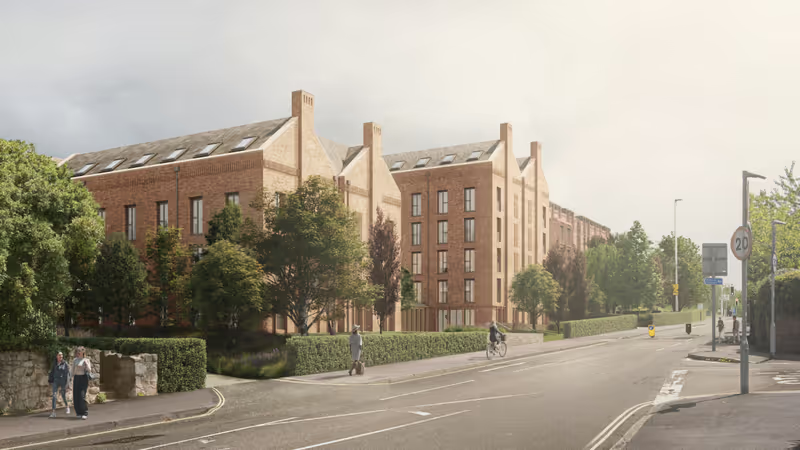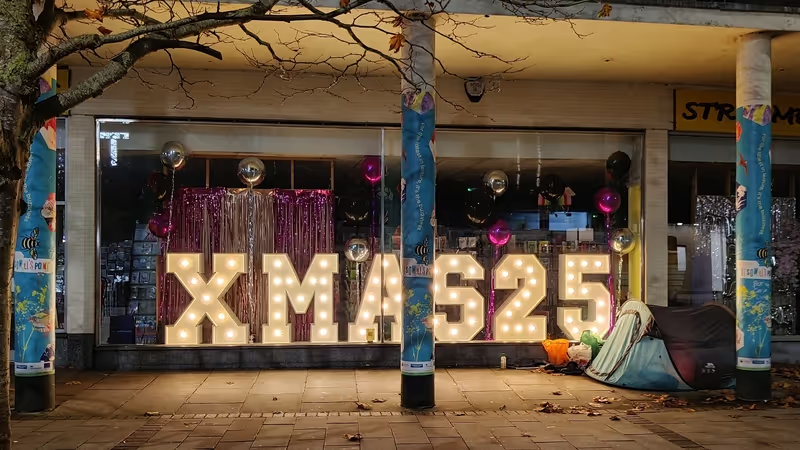Exeter City Council is to sell part of Grace Road Fields to enable the construction of a district heating network plant, with the rest of the greenfield site to be annexed for “strategic mixed use” housing policy allocation under the new Exeter Local Plan.
The fifteen acre ex-playing field sits between Exeter Ship Canal and the railway line with the new Marsh Barton station at its north-west corner. It forms part of Riverside Valley Park, which straddles the River Exe as far as the Countess Wear bridges.
The city council met in private last week, with press and public excluded, to approve an executive committee decision, also taken in private, to sell part of the field to Exeter Energy Limited, a Leeds-based company controlled by 1Energy Group and Asper Investment Management.
The company will receive a £42.5 million share of £80.6 million government funding to construct a heat exchanger plant intended to power an as-yet unplanned underground Exeter heating network.
Heat will be extracted from water pumped from the River Exe, with an on-site air source heat pump and data centre heat exchanger also planned. The company says the adjacent Marsh Barton waste incinerator may also be used as a heat source, as will back-up gas boilers.
Exeter Energy says the new district heating network will save “over 13,000 tonnes of carbon emissions a year”. Marsh Barton incinerator, Exeter’s biggest single source of carbon emissions, is largely responsible for the 33,500tCO2e of greenhouse gas emissions that the city’s solid waste disposal produces each year.
A £7.3 million publicly-funded project to supply 2,500 new homes with waste heat from the incinerator was abandoned three years ago after most of the developers involved in the scheme would not pay network connection costs.
 Illustrative district heating plant site layout plan. Source.
Illustrative district heating plant site layout plan. Source.
Subject to planning approval, works on the Grace Road Fields district heating plant are expected to begin in spring next year and take around eighteen months to complete.
50 vehicles a day are expected to access the site via Water Lane, half of which would be HGVs. HGV visits would then fall to around a five a day after the first six months.
Six months of construction works are also expected on the bank of the River Exe, near Duckes Marsh bridge.
Five HGVs and five other vehicles are expected to access this site each day via the shared use pedestrian and cycle path from Bridge Road.
Potential underground heat network routes are being discussed with Devon County Council, acting as highways authority. Routes will depend on which organisations connect to the network, the maximum extent of which will be limited.
The company says detailed archaeology and unexploded ordinance surveys will be carried out along the chosen routes.
Its first customers may be able to receive heat from the network by the end of 2026.
 Illustrative district heating network maximum extent map. Source.
Illustrative district heating network maximum extent map. Source.
Exeter Energy opened a public consultation on its Grace Road Fields plans and held both planned public exhibitions before the council approved the sale of the land last week.
Notice of the decision was published in the council executive forward plan in June, but the notice did not say anything about the council plan to appropriate the rest of Grace Road Fields for redevelopment at the same time as approving the sale.
Grace Road Fields is designated as a recreation ground in the city council’s Riverside & Ludwell Valley Parks Masterplan, a supplementary planning document (SPD) that forms part of the local development framework under the current local plan and which will remain in force until 2026.
The council says: “The need for this plan is driven largely by the growing population of the city, which is having an indirect impact on the Exe Estuary, a protected European wildlife site. This impact has to be mitigated, by law.
“One of the elements of the mitigation strategy is the enhancement of alternative natural greenspace, and the council has identified these two parks for this purpose.
“We need to make the parks more attractive for people, particularly those walking the dog, thus taking pressure off the estuary and its wild bird populations.”
It adds: “Fundamentally, the plan sets out where new areas of public recreational space can be created, and where improvements to existing space can be made”.
 Grace Road Fields in morning mist
Grace Road Fields in morning mist
The valley parks masterplan itself says: “Grace Road playing fields and the Water Lane tip are currently disjointed from the parks located on the west side of Clapperbrook swing bridge.
It continues: “Activating this area of the site can help to improve the area to make it a desirable recreation area for all”, and says that the then unbuilt Marsh Barton station would provide “significant opportunity for the area to develop as a main gateway to the valley parks.”
Acknowledging its under-use as playing fields, it says Grace Road Fields is “a key place for woodland planting, and forest clearings and openings can be created to provide opportunities for picnicking and fire pits for families to gather around.
“A picnic and barbecue area could be developed with a seasonal camping ground, and the field could be rented for festivals and events, from country fairs to farmers markets or folk festivals.
“This can all be supplemented by a peripheral walking route that will connect to the Alphin Brook to enable people to access 20 hectares of new natural green space.”
The masterplan also proposes a new canal basin at the eastern end of the fields.
 Riverside & Ludwell Valley Parks Masterplan proposals map, February 2016
Riverside & Ludwell Valley Parks Masterplan proposals map, February 2016
Three years after agreeing the valley parks masterplan, the council adopted its “Liveable Exeter Vision for a Transformational Housing Delivery Programme”.
The accompanying strategic document identified several development sites which, the council said, would help make Exeter “one of the leading global cities in the area of responding to urban challenges and environmental futures”.
Among them was the Water Lane site, shown as extending the Water Lane Regeneration Area identified in the valley parks masterplan further north towards Haven Road, but not further south.
 Liveable Exeter Vision for a Transformational Housing Delivery Programme Water Lane redevelopment layout map, February 2019
Liveable Exeter Vision for a Transformational Housing Delivery Programme Water Lane redevelopment layout map, February 2019
Three more years passed, then the outline draft of the new Exeter Local Plan was published in September 2022.
It was accompanied by a Housing & Economic Land Availability Assessment that described Grace Road Fields as “unsuitable for housing and employment development on flood risk grounds”.
The outline draft plan nevertheless said that, while most of Water Lane was already allocated for redevelopment, “the city council proposes that the existing allocation should be expanded in the Exeter Plan to cover the whole Water Lane site”.
This meant that Grace Road Fields, which was still designated (mostly) as playing pitches, would nevertheless be included in the Water Lane redevelopment site allocation.
 New Exeter Local Plan outline draft Water Lane redevelopment site allocation map, September 2022
New Exeter Local Plan outline draft Water Lane redevelopment site allocation map, September 2022
In October last year the council then published the draft version of a new Water Lane SPD.
This said proposals for Grace Road Fields should “enhance nature and biodiversity”, “improve recreational opportunities”, “improve access to the canal” and “establish the area around Marsh Barton station as a regional destination for recreation and water-related activities”.
It classified the site under National Model Design Code rubric as “Nature N1 - Green Infrastructure” and said uses being considered included: “Biodiversity Net Gain habitat bank, woodland creation, recreational area, wildlife hub, canal basin/marina, energy centre, allotments and solar farm.”
It added: “The Riverside & Ludwell Valley Parks masterplan should be used for ideas and reference” and even included input from a citizen’s panel that referred to the masterplan, saying: “An urban campsite at Grace Road playing fields by Marsh Barton station would be a great attraction”.
 Water Lane Supplementary Planning Document regulating plan, July 2024
Water Lane Supplementary Planning Document regulating plan, July 2024
However the council also published the full draft of the new Exeter Local Plan for public consultation at the same time. This simply describes Grace Road Fields as “now disused”.
An accompanying proposals map annexes the section of the Riverside Valley Park it occupies, along with the canal itself, and allocates them for “strategic mixed use” as part of the Water Lane redevelopment site under policy H2.
Policy H2 – “Housing allocations and windfalls” – identifies sites for housing development, specifying the number of homes to be delivered in each case. This rose from 1,180 to 1,600 at Water Lane in the year between the publication of the outline draft and full draft of the plan.
The Water Lane site allocation policy included in the full draft plan provides granular detail on many aspects of the proposed redevelopment, but it doesn’t say anything about Grace Road Fields.
 New Exeter Local Plan full draft proposals map excerpt, October 2023
New Exeter Local Plan full draft proposals map excerpt, October 2023
Last Tuesday, the council adopted the final version of the Water Lane SPD just before it decided, at the same meeting, to sell part of Grace Road Fields to Exeter Energy and formally appropriate the rest for redevelopment.
Until the new Exeter Local Plan is adopted the Water Lane SPD will be a material consideration in determining planning applications that come forward in the area, including at Grace Road Fields.
But once the new Exeter Local Plan is adopted the “strategic mixed use” housing policy designation that will apply to the whole, extended Water Lane redevelopment site will have greater weight in planning decisions at Grace Road Fields than the SPD.
The council currently expects to adopt the new local plan at the end of next year, with the first planning applications coming forward under the new plan in 2026 – at the same time as the Riverside & Ludwell Valley Parks masterplan expires.
Comments on Exeter Energy’s plans can be submitted using an online feedback form, by email to exeter@1energy.uk or by post to P.O. Box 359, Saltash PL12 9AS until Thursday 1 August 2024.
The city council said it would publish notices in relation to the disposal of the land, but did not say when or where.










